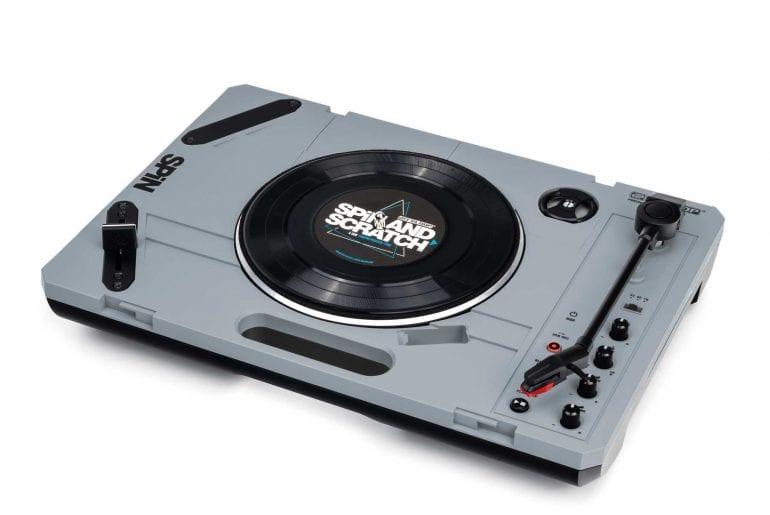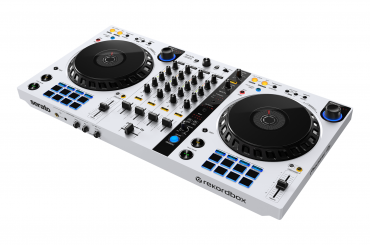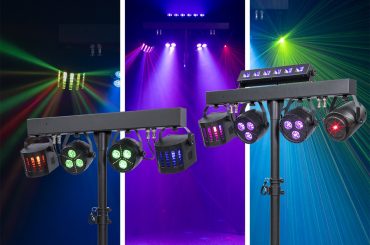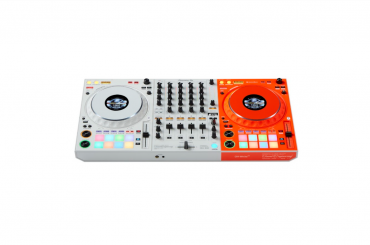In the last few years, the portable scratch scene has really taken off. What started as a very niche sect has become a relatively mainstream facet of DJ culture, both in the United States and internationally.
The appeal of portablism is plain to see: elaborate scratch tricks, cuts, and combos are meant to be shared, but lugging around a battle-ready mixer and a heavy turntable isn’t always easy. Portablism’s roots started off with DJs using miniature turntables and modifying them; for instance, adding crossfaders. As the number of portablists continued to grow, DJ equipment manufacturers began to see potential in this market. Some companies released dedicated portable crossfaders, and others released entire all-in-one scratch turntables for portablists.
While it is possible to modify a miniature turntable to include all the trappings needed by portable DJs, there are now dedicated turntables custom-designed for portablists. This is where Reloop’s Spin fits in.
The Unit: The Spin is a belt-driven portable scratch turntable manufactured by German DJ gear and pro audio company Reloop (distributed Stateside by Newbury Park, Calif.-based American Music & Sound). It promises to give portablists all the features they want, enclosed in a reliable and carrying-friendly design. It comes in the form factor of a briefcase, which, from a style perspective, I think is very cool.
There is an integrated grab handle at the top, and there are two latches that hold the cover in place. The color scheme is black on grey, and the body is entirely plastic, but I think that’s probably necessary to keep the device lightweight and easily portable. In my time with it, the Spin never felt flimsy, and I think it should easily survive long-term portablist duties.
On the top of the unit, there’s a 7-inch platter that doesn’t rock too much when being heavy-handed. The unit ships with an included Reloop-branded slipmat. The tonearm has a good weight to it, and there are an included stylus and cartridge assembly. It’s weighted enough to not be easily bounced during scratching and stows the cartridge in a trench recessed into the deck, which guards the stylus.
To the right of the platter, there is a play/pause button, a button to pair the unit by Bluetooth, and a button to control recording. Bluetooth makes an appearance on the Spin because users can pair their own devices and stream beats and songs to scratch over. In my testing, I never found there to be too much latency, and the signal quality sounded good. There’s also an auxiliary input through a 1/8-inch headphone jack if users aren’t feeling Bluetooth.
Recording & Other Features: The record feature is also handy, especially considering how much the portablism culture involves sharing routines and posting them online. You connect a formatted USB drive to a port on the side of the unit. Pressing the record button once starts recording, and pressing it again stops it.
To the very right, there are controls for the turntable speed (switchable from 33, 45, and 75), pitch, tone, auxiliary input (Bluetooth or analog) level, and output volume (either through the built-in speaker or through one of the outputs). There’s also a 7-inch record puck adaptor that sits in the top right when not in use.
The unit has a built-in speaker, which sounds good and is loud enough for small-group jam sessions. If more volume or the privacy of headphones are desired, there are outputs on RCA and headphone jacks to connect the unit to headphones or larger speakers.
On the back of the unit, there’s a micro-USB port to connect the unit to a power source, a power switch, an RCA output, two headphone outputs (one is 1/8-inch headphone-jack sized, and the other is ¼-inch), a full-size USB port for connecting a storage device for recording sessions, and a Kensington lock.
Power is an interesting conversation with the Spin: the unit can be powered by any power source that can send at least 5 volts and 2 amps. This could be a car charger, a cigarette lighter, a wall socket, a computer, or even an external battery pack. There is also a slot on the bottom of the unit for rechargeable batteries (not included); when the unit is plugged in and there are batteries in place, the Spin can even charge the batteries.
Each Spin comes with a slipmat and a 7-inch scratch record included. There’s also the free Super Spin Duck Looper smartphone application created by turntablist legend DJ Babu of The Beat Junkies. The app is an arcade-style beat machine. Users can select from 10 beat loops and tweak their tempo and pitch to create grooves to scratch over. It’s a fun addition, but certainly not earth-shattering.
What’s Best: The truly killer feature of the Reloop Spin is the included full-size, twin-rail, 45mm crossfader located on the bottom left of the unit. There is a slot for the fader on the top left: you can move the fader from its current position to the other one with just two screws and a simple connection. You also have the ability to swap out the fader for a preferred one, with included connections and a screwdriver.
If you want to install two faders at once, I’m told the secondary one can act as a line fader. Two things to note about the fader. One, the curve is short enough of a cut for scratching, but it isn’t modifiable. Second, there’s no fader-reverse, meaning that if you want to reverse the fader, you have to physically reinstall it in the other direction.
In my use with the device, I really enjoyed it. It’s lightweight and easy to carry, and it’s got nearly everything a portablist could want from an all-in-one unit. Its biggest competitor is probably the Numark PT01 Scratch, but there is a considerable difference in price: the Numark unit costs around $129, and the Reloop goes for $249. The Reloop Spin, however, packs in significantly more features than the Numark, including Bluetooth-streaming capability and the record-to-USB functionality.
DJ Times Magazine is copyright © 2019 by DJ Publishing, Inc. www.djtimes.com








